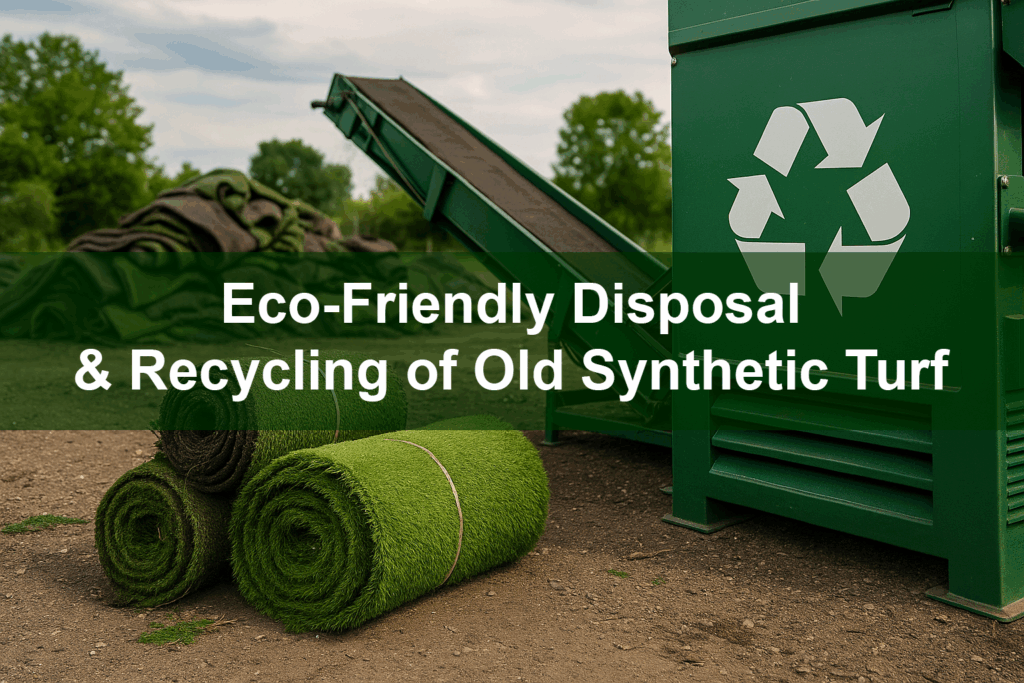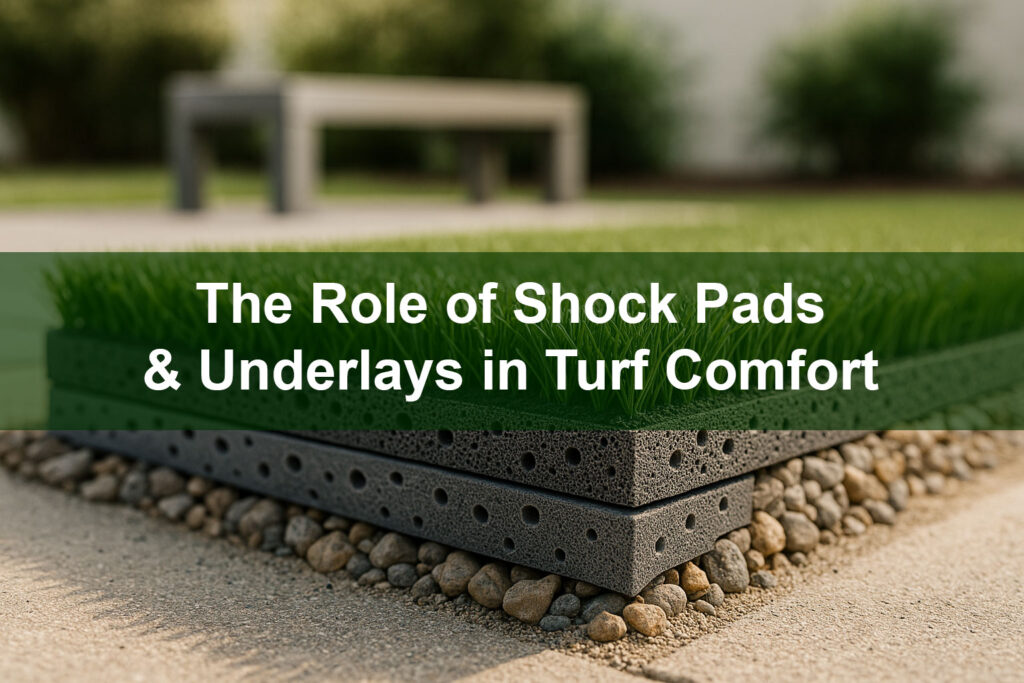Eco-Friendly Disposal & Recycling of Old Synthetic Turf
As artificial grass installations age and technology evolves, homeowners and commercial property managers face the question: what happens to turf at the end of its life? Disposing of synthetic grass in landfills not only squanders valuable materials but also contributes to environmental pollution. Fortunately, eco-friendly disposal and recycling options are expanding, allowing old turf to be repurposed into new products or processed into sustainable infill. In this comprehensive guide, we’ll explore responsible end-of-life strategies for synthetic turf—reducing waste, conserving resources, and minimizing your environmental footprint.
Whether you’re replacing a residential lawn, renovating a commercial landscape, or decommissioning a sports field, this guide provides actionable insights to help you navigate disposal regulations, locate recycling programs, and implement best practices for a circular turf economy.
What You’ll Learn in This Guide:
- Environmental impacts of turf landfilling
- Benefits of recycling vs. disposal
- Mechanical and chemical recycling processes
- Reuse applications for recycled turf materials
- How to find local recycling and drop-off centers
- Cost and logistics of eco-friendly disposal
- Legal requirements and producer responsibility
- Planning for end-of-life turf replacement
1. The Growing Challenge of Turf Waste
Each year, millions of square feet of synthetic turf reach the end of their lifespan—typically 10–20 years. Traditional disposal methods send this material to landfills, where polyethylene fibers, latex backings, and infill materials persist indefinitely. As turf installations accelerate, landfill space becomes scarce and environmental concerns grow. Turf waste can break down into microplastics, contaminating soil and waterways. Moreover, transporting heavy turf rolls to landfills consumes fuel and emits greenhouse gases. Recognizing these challenges, industry and environmental groups are developing circular economy solutions to recycle and repurpose old turf, transforming a waste problem into an opportunity for sustainable resource management.
2. Environmental Benefits of Recycling vs. Landfilling
Recycling synthetic turf reduces landfill dependency and related emissions. By diverting turf from dumpsites, recycling conserves raw materials—like petroleum-based plastics—and lowers energy consumption in manufacturing new products. It also minimizes microplastic release. Studies show that recycled turf can replace up to 30–50% of virgin materials in new applications, cutting carbon footprints by up to 40%. Additionally, recycling supports local economies by creating processing and remanufacturing jobs. Opting for eco-friendly disposal aligns with corporate sustainability goals, enhances green building certifications (e.g., LEED), and demonstrates environmental stewardship to communities and regulatory bodies.
3. Mechanical Recycling: Shredding & Separation
Mechanical recycling begins with turf shredding. Industrial granulators break down turf rolls into small chips, separating fibers from backing and infill. Vibrational screens and air classifiers then sort materials by size and density. Polyethylene and polypropylene fibers are washed, dried, and pelletized for reuse in plastic products like decking boards, park benches, or drainage tiles. Latex and polyurethane backings can also be processed into crumb rubber or fuel additives. This physical recycling method is energy-efficient and scalable—ideal for large-volume commercial turf removal. When scheduling turf replacement, coordinate with recycling facilities to ensure clean, contaminant-free material pickup and processing.
4. Chemical Recycling: Depolymerization & Solvent Recovery
Chemical recycling—or feedstock recycling—involves breaking polymer chains into monomers or oligomers via heat, pressure, or solvents. Advanced depolymerization plants can convert polyethylene fibers back into base hydrocarbon oils, which serve as feedstock for new plastics. While more complex and capital-intensive than mechanical recycling, chemical processes can handle mixed or contaminated turf that mechanical methods reject. This approach nirtrogen recovery from polyurethane backings and produces high-purity outputs suitable for virgin-grade applications. Emerging partnerships between turf manufacturers and chemical recyclers promise closed-loop systems, further reducing reliance on petroleum extraction.
5. Reuse Applications for Recycled Turf Components
Recycled turf materials find new life in diverse applications. Shredded fibers become acoustic insulation panels or erosion-control mats. Reclaimed infill—especially crumb rubber—is used in playground surfaces, athletic tracks, and as base under pavers for leveling. Composite materials blending recycled turf with wood or mineral additives produce durable landscaping pavers and parking curbs. Municipalities repurpose recycled turf as roadbed padding or noise barriers. By specifying recycled-content products in landscaping and construction projects, property owners close the loop and support sustainable material markets.
6. Locating Recycling Programs & Drop-Off Centers
Finding local recycling options requires research. Start with turf manufacturers—many offer take-back or buy-back initiatives. National recycling directories list facilities certified to process synthetic turf. Some waste management companies provide curbside or roll-off services for turf removal. Additionally, community environmental events or landfill diversion programs may accept turf at designated drop-off sites. When engaging a turf installer, inquire about disposal services as part of the project package. Coordination ensures compliance with regional regulations and avoids illegal dumping fines.
7. Small-Quantity & DIY Disposal Options
Homeowners replacing small lawn patches may lack access to large-scale recyclers. For quantities under 200 sq ft, consider repurposing turf for indoor/outdoor mats, pet areas, or craft projects. Schools and community centers often welcome turf donations for play areas. Alternatively, coarse turf can serve as ground protection during painting or renovations. When disposal is unavoidable, contact local waste authorities for special drop-off days. Bag smaller sections to limit scattering and place at designated green waste or bulky-item pick-up points.
8. Regulatory & Producer Responsibility Trends
Extended Producer Responsibility (EPR) policies are emerging in North America and Europe, requiring turf manufacturers to finance end-of-life management. Anticipate new regulations mandating minimum recycled content in turf products and standardized disposal guidelines. Stay informed by monitoring local environmental agency announcements and industry associations. Voluntary ecolabels and certification programs—such as ISO 14001 and Cradle to Cradle—offer frameworks for sustainable turf lifecycle management, benefiting both producers and consumers.
9. Cost Considerations & Budgeting
Recycling typically costs more than landfill tipping fees—ranging from $0.50 to $2.00 per square foot—depending on transportation distance and processing complexity. However, factoring in potential landfill surcharges, carbon offsets, and corporate sustainability credits can offset recycling expenses. For commercial clients, negotiating multi-site service agreements or volume discounts with recyclers reduces per-unit disposal costs. Include disposal and recycling line items in your turf replacement budget to avoid last-minute fees and align with green procurement guidelines.
10. Planning for End-of-Life: Proactive Strategies
Integrate end-of-life considerations when selecting new turf. Opt for products labeled recyclable or remanufacturable. Register your turf installation with manufacturer take-back programs. Maintain documentation of turf specifications and disposal plans for future reference. Educate stakeholders—facility managers, tenants, and landscapers—on proper disposal methods to ensure consistent, eco-friendly practices at project turnover.
Conclusion & Next Steps
Transitioning from landfill disposal to recycling and reuse of synthetic turf is essential for sustainable landscapes. By understanding recycling processes, exploring reuse options, and staying abreast of regulatory shifts, homeowners and commercial clients can minimize environmental impacts and support a circular turf economy. Ready to responsibly retire your old turf? Contact our team via the Buy-Grass contact page or explore certified recycling partners on our services page for turnkey disposal solutions.
Make Your Turf Replacement Sustainable
Reach out to Buy-Grass for eco-friendly turf recycling and disposal services today.







